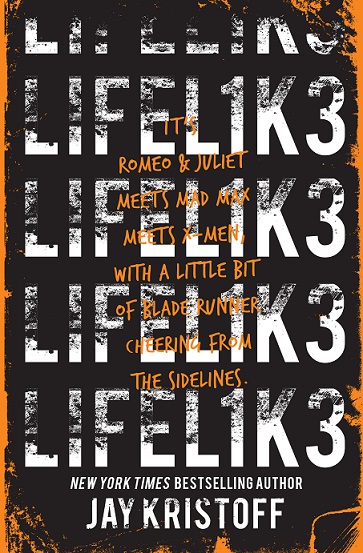
Writers Victoria intern Ellen O’Brien talks to Jay Kristoff about his new novel ‘LIFEL1K3’.
Your latest book, ‘LIFEL1K3’, follows 17-year-old Eve as she tries to survive in an irradiated, post-apocalyptic wasteland. Your novels often feature chaos and carnage, including plagues, invasions and intergalactic wars. Where do you look for ideas and inspiration? Do you see our world heading in that direction?
It’s not a certainty, but it’s certainly a possibility, and for me, fiction is about exploring possibilities. ‘LIFEL1K3’ is set in a world where several of the futures we’re headed toward (nuclear war and environmental collapse) have both come to pass. It’s also a world ruled by corporations rather than governments, which is already a reality in several so-called democracies.
Do I see us ending in a place like the world of ‘LIFEL1K3’? Honestly, unless we do something to stop ourselves, probably. And that’s a depressing thought, but denial as a strategy hasn’t got us very far. 60% of the Great Barrier Reef is dead and never coming back. Main streets in Florida are underwater. The sea level rise caused by the loss of our glaciers is set to displace tens of millions of people in our lifetime. And yet, nobody seems to be talking about it. Nobody seems to care.
I am available for weddings and children’s birthday parties, in case you were wondering. 🙂
Your novels often combine a range of different genres, including young adult fiction, fantasy, sci-fi and steampunk. What is it about these genres that appeals to you? When did you first fall under their spell?
I like playing in genres that explore the possible. Even my fantasy worlds tend to be rooted in delving into what could be. That’s the great thing about writing genre—exploring the problems of the Now through the lens of What Might Be.
I was probably eight or nine when I first caught the bug. The first fantasy novel I ever read was ‘The Hobbit’—that was the first time I really understood there were books out there written for kids like me.
You write at an incredible pace. This year, you’re set to have three other novels published for three different series. What’s your secret? Do you sleep? Do you ever get writer’s block?
It turns out I’m something of a workaholic—it took me a while to discover this, but I never really had a job I loved until this one.
But how could I not love it? I get to sit around and write stories about robots and space and magic and assassins for a living. I pay my electricity bill with this stuff. And I’m incredibly lucky to be able to do that, and I don’t want to take it for granted. Besides which, it’s just incredible amounts of fun. So, I’ll be sitting with a few weeks downtime between edits or drafts and I’ll just start working on something else. I have my next two series already worked out in my head. I’ve always had an overactive imagination. Now I just get paid to use it, instead of getting yelled at about it.
In terms of writer’s block, I sometimes get stuck on a particular project. But that’s the great thing about working on multiple books at once. It’s very rare you’re stuck on all of them at the same time, and the brain has a wonderful habit of solving problems when you’re not actively looking for solutions.
‘LIFEL1K3’ has been described as “part Romeo and Juliet, part Terminator, and all adrenaline”. What are your top tips for building momentum?
‘LIFEL1K3’ is probably the fastest paced book I’ve written. The momentum is mostly built around revelation and actual physical motion–the characters are learning something new or running from or toward something in virtually every scene.
Physical motion/action isn’t something that will work in every genre, and nor should it. But giving your story motion through information and revelation—and having the answers to your initial questions leading to yet more questions—is something that will work in many. Leaving a question mark at the end of every scene or chapter (Who is that? How are they going to get out of this? Why are they doing that?) can keep your reader turning pages.
The ‘Illuminae Files’ trilogy that you co-wrote with Amie Kaufman won multiple awards and topped the New York Times best seller list. Your other novels have also been met with delight and enthusiasm from people across the globe. Do you still find it daunting when one of your books comes out?
To be fair, we didn’t top the NYT list, we only got to number 2. 🙂
But yes, absolutely. Especially for a new series I’ve signed up to write two more books for! But part of doing this job is understanding there’s a point you need to let go—the book is written, you’ve made it the best book you could, nobody really understands what makes bestsellers or why. You just hope each book will find its audience and understand some things are beyond your control.
Fear is the mindkiller.
How does your writing process change when you’re writing novels by yourself, compared to when you’re co-writing with Amie?
There’s far more planning involved in my co-authored work. I’m usually a pantser when it comes to my solo projects—I tend to jump into a story with some vague directions and maybe a signpost I know I need to pass along the way, then just start driving. But working with a co-author, things are for more meticulous. It makes for a nice contrast.
Co-authoring also tends to be a little easier in terms of problems solving, because you’ve got two heads instead of one. And of course, it’s less lonely, and more fun to have someone to share the victories with.
Your books are now published in over 30 countries. What advice would you give to writers who are just starting out?
Believe in yourself. It sounds a little saccharine, but self-belief is the most powerful weapon in any artist’s arsenal.
No matter what you do—writing, acting, music, interpretive dance—if you decide you’re going to make art, you’ll be constantly accosted by people who will happily give you all the reasons why you Can’t, and you Won’t and you Shouldn’t Even Try. And making art really is a crazy thing to be doing with your time. The odds you’ll ever pay your electricity bill with the proceeds are small. At some point in every artist’s life, they’ve looked at themselves in the mirror and asked themselves “Am I a fool to be doing this?”
You’ve got to fight through that moment. And push those people aside. Because as crazy as it is, and as long as the odds might be, making art is a better way to spend your time that wasting it in front of the television or on the goddamn internet.
So, believe.
|
Jay Kristoff is the ‘New York Times’ and internationally bestselling author of ‘THE NEVERNIGHT CHRONICLE, THE ILLUMINAE FILES’ and ‘THE LOTUS WAR’. He is the winner of four Aurealis Awards, an ABIA, nominee for the Locus award, David Gemmell Morningstar and Legend awards, named multiple times in the ‘Kirkus’ and Amazon Best Teen Books list and published in over thirty countries, most of which he has never visited. He is as surprised about all of this as you are. He is 6’7 and has approximately 12,665 days to live. He abides in Melbourne with his secret agent kung-fu assassin wife, and the world’s laziest Jack Russell. ‘LIFEL1K3’ is published Allen & Unwin |
 |
